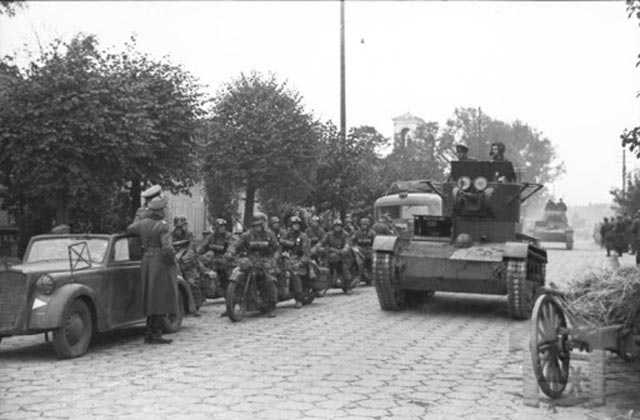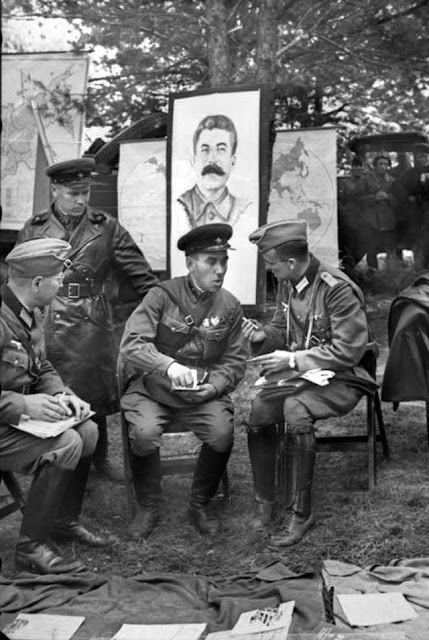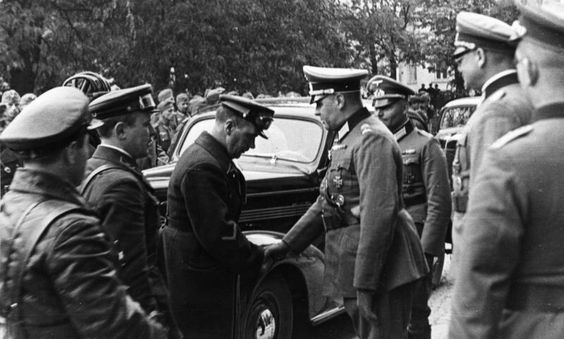Friday 22 September 1939
 |
| German and Soviet soldiers conversing, 22 September 1939. |
Battle of Poland: German forces under the command of General Heinz Guderian (XIX Corps) have been in possession of territory on the eastern side of the Bug River after heavy fighting. Soviet forces now arrive to assume control of that area under the secret terms of the 23 August 1939 Ribbentrop-Molotov Pact. Kombrig (Commanding officer of the brigade) Semyon Moiseevich Krivoshein of the Soviet 29th Tank Brigade, who had crossed the Polish border on 17 September, reaches Brest-Litovsk on the morning of 22 September. Krivoshein finds the Germans looting the town (he later claims), with Guderian himself comfortably ensconced there. The Germans have been there for several days already and really don't want to leave.
 |
| A Soviet tank (perhaps a T-26) rolls down the street during the joint Soviet-German parade held on 22 September 1939 (Gutjahr, Federal Archive Bild 101I-121-0012-30). |
After some back-and-forth, Krivoshein visits Guderian at the latter's headquarters. Guderian acknowledges that he must relinquish the town, but proposes to make the German departure a formal occasion, complete with a parade. Krivoshein is not very enthusiastic about the idea, having just completed a quick advance to reach the city. He does not want any extra hassles because his advance is being watched closely by Moscow. However, Krivoshein agrees to humor Guderian by supplying a few token battalions to support the ceremony, along with a military band. The informal parade begins at 16:00, complete with festive bunting. Both German and Soviet troops march through hastily constructed "Victory Arches" in front of a reviewing stand on which stand the two grinning commanding officers. It turns into a bizarre spectacle in light of later events that a lot of participants speak little of later.
 |
| Guderian and Krivoshein at the Brest-Litovsk parade on 22 September 1939 (Gutjahr, Federal Archive Bild 101I-121-0011A-22). |
Krivoshein later greatly downplays the event in his memoirs and implies that the Soviet forces were merely present as onlookers and not active participants. He recalls that he did not allow his troops to march with the German forces, who were rested and looked more presentable. This recollection seems doubtful in light of the photographic evidence. Obviously, subsequent events made downplaying any cooperation or "celebrations" with the Germans a political necessity, and Soviet military historical works are notorious for their impeccable political hindsight. In other words, all military memoirs that came out of Soviet Russia were politically scrubbed to remove any embarrassing details and always must be read with that in mind. A celebratory parade with Wehrmacht troops certainly was awkward to explain in the post-war world.
 |
| A German honor guard awaits the arrival of the Soviet commander during the 22 September 1939 joint Soviet-German parade ( Federal Archive Bild 101I-121-0012-15). |
After the parade, the German forces withdraw to the west bank of the Bug River as pre-ordained. This event has attracted much publicity in subsequent years due to the subsequent estrangement of the two forces. It is believed that the 22 September 1939 parade was the only such event that ever took place involving the two sides. Russian historians, in particular, are quick to minimize the event as being merely a "ceremonial departure" of the German forces, but the photographic record suggests that the Soviets participated without much reservation.
 |
| Soviet and German soldiers, sitting amicably beneath a portrait of Joseph Stalin in Brest-Litovsk on 22 September 1939. Compare this to the photo immediately below (Böttcher, Federal Archive Bild 101I-121-0011-20). |
For instance, it is highly doubtful that the Germans were carrying around posters of Joseph Stalin, but the photographic evidence shows such posters somehow materialized in Brest-Litovsk on the day of the parade as part of the overall celebration. Incidentally, similar posters of Stalin showed up and were displayed in April 1945 on the day of the meeting of Soviet and US forces. In fact, the photos from the two widely separated events look strikingly similar, and both became awkward later for political reasons. Quite a coincidence.
 |
| A photo that was taken at the celebration marking the 25 April 1945 meeting of Soviet (First Ukrainian Army) and US (Fifth Corps of US First Army) troops at Torgau, Germany. Note the prominently placed portrait of Joseph Stalin, which is oddly similar to the 22 September 1939 photograph of the Soviet-German meeting at Brest-Litovsk above (note there also is a small portrait of President Roosevelt which is lined in black crepe paper due to his recent passing). Apparently, Soviet armies carried these Stalin portraits as a matter of course ((Photo by Photo12/UIG/Getty Images)). |
The Polish commander of Lwów hands it over to the Soviets.
Polish units of the 39th Infantry Division have been defending the village of Cześniki near Zamość. They have been holding off the German 27th Infantry Division and 4th Light Division. The 39th Infantry Division now is ordered to relieve Lwów and breaks through the German lines. With that city suddenly being surrendered, however, they are now on the move with nowhere to go.
Separately, "Honorary Colonel of the 12th Artillery Regiment" Generaloberst Werner Thomas Ludwig Freiherr von Fritsch is killed in Praga while "inspecting the front." He is picked off by either a Polish sniper or a machine gun. Von Fritsch is believed to have voluntarily exposed himself to enemy fire. This is due to his lingering disgrace over the false accusations of homosexuality used to depose him from his position as Commander in Chief of the Heer.
Western Front: The French claim to be approaching Zweibrücken in the Siegfried line. French radio also reports that the Wehrmacht has lost 150,000 men so far in the conflict. The actual figure is maybe 10% of that.
Battle of the Atlantic: The steamer Arkleside is torpedoed and sinks. A Grimsby trawler also is sunk.
Romanian Government: The government executes several members of the Iron Guard, including the assassins of the Romanian Prime Minister, in Bucharest.
Allied Supreme Command: In Hove, Sussex, the second meeting of the Allied Supreme War Council takes place between the British and French representatives. Nothing much is accomplished beyond issues of supply.
British Homefront: The Metropolitan Police Commission in London reports that road accidents have tripled so far in September. That is likely due to the blackout. The courts are clogged with blackout violations. Gasoline is rationed.
September 1939
September 1, 1939: Invasion of PolandSeptember 2, 1939: Danzig AnnexedSeptember 3, 1939: France, Great Britain Declare WarSeptember 4, 1939: First RAF RaidSeptember 5, 1939: The US Stays OutSeptember 6, 1939: Battle of Barking CreekSeptember 7, 1939: Polish HQ Bugs OutSeptember 8, 1939: War Crimes in PolandSeptember 9, 1939: The Empire Strikes BackSeptember 10, 1939: The Germans Break OutSeptember 11, 1939: Battle of KałuszynSeptember 12, 1939: The French Chicken OutSeptember 13, 1939: The Battle of ModlinSeptember 14, 1939: Germany Captures GdyniaSeptember 15, 1939: Warsaw SurroundedSeptember 16, 1939: Battle of JaworówSeptember 17, 1939: Soviets Invade PolandSeptember 18, 1939: Lublin FallsSeptember 19, 1939: Germans, Soviets Hook UpSeptember 20, 1939: the Kraków Army SurrendersSeptember 21, 1939: Romania ConvulsesSeptember 22, 1939: Joint Soviet-German Military ParadeSeptember 23, 1939: The Panama ConferenceSeptember 24, 1939: The Luftwaffe Bombs WarsawSeptember 25, 1939: Black Monday for WarsawSeptember 26, 1939: Warsaw on the RopesSeptember 27, 1939: Hitler Decides to Invade FranceSeptember 28, 1939: Warsaw CapitulatesSeptember 29, 1939: Modlin Fortress FallsSeptember 30, 1939: Graf Spee on the Loose
2021









